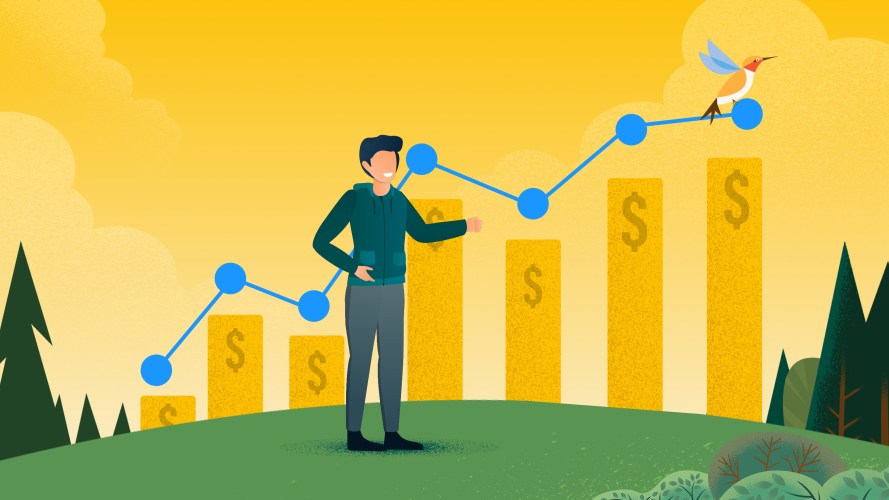Dynamic Pricing Demystified: How to Ride the Highs and Lows in the Market and Win

Optimize revenue, manage demand, and enhance customer satisfaction by adapting your prices to the state of the market.

You have a hot product ready to launch. Everyone wants to get their hands on it, so you know you can charge a premium right now. But how do you set your prices for the long term? You need to charge what the market will bear, and that’s an ever-changing target. This is where dynamic pricing comes into play.
If you’ve used a rideshare app, booked a hotel, or flown on an airline, you’ve experienced dynamic pricing. If you’re unsure how to set prices for your business, you’re in the right place to learn. We’ll dive in to the fundamentals of dynamic pricing, the most common types, and tips for getting started.
What you’ll learn:
- What is dynamic pricing?
- When to use dynamic pricing
- 5 most common types of dynamic pricing
- Dynamic pricing vs. elastic pricing
- Drawbacks of dynamic pricing
- 4 tips for implementing dynamic pricing
Unify sales, finance, and legal on the #1 AI CRM
When sales, finance, and legal are disconnected, the customer feels the pain. Learn how Revenue Cloud can help.



What is dynamic pricing?
Dynamic pricing — also known as surge or demand pricing — is a pricing strategy in which businesses set flexible prices for their products or services based on changing market demands. Businesses may adjust their prices in real time based on factors such as demand, supply, competition, and customer behavior. The goal of this pricing model is to optimize revenue and profit by adapting to the state of the market.
When to use dynamic pricing
While it might seem like the only benefits of this pricing approach are to the business, there are potential benefits for buyers as well. For example, loyal and long-term customers typically receive discounts from brands throughout the year. For these folks, there’s the potential for great rewards, with off-peak pricing approaches sometimes yielding much higher-than-normal discounts — it can be a win-win.
Here are a few examples of when and why to use dynamic pricing:
Meet customer demand
Prices may increase during periods of high demand and decrease when demand is low. For example, ride-sharing services might increase fares during rush hours or special events, when there’s higher-than-normal demand for rides.
Handle changes in supply
Prices may also vary based on the availability of products or services. For instance, hotels typically increase room rates when they have limited availability during peak seasons or when there’s a local event happening — or decrease rates during slow seasons to encourage more bookings.
Compete in a crowded market
Competition-based pricing often involves monitoring competitors’ prices and adjusting prices accordingly to stay competitive in the market. For example, a new cellphone manufacturer might set their prices just below the competition to stand out and compete with popular existing brands.
Adapt to changing customer behavior
Data from your CRM can help you analyze customer behavior, purchasing patterns, and willingness to pay. You can then adjust your prices to maximize revenue from different customer segments. Streaming platforms are one example where not all customers pay the same price for the same service. Some customers are willing to pay more than the monthly subscription fee for add-ons, family accounts, and ad-free tiers, for example.
5 most common types of dynamic pricing
Dynamic pricing strategies are commonly used across industries, including retail, hospitality, transportation, e-commerce, and entertainment. They help businesses optimize revenue, manage demand, and enhance customer satisfaction. Let’s break down the five most common types:
1. Demand-based pricing
This pricing strategy suggests that when demand goes up or down, the price will follow. Businesses can use demand pricing to maximize their profits by charging higher prices when there’s more demand and lower prices when there’s less.
- Example: Utility companies use dynamic pricing to manage and optimize energy demand. During peak hours when more people are using the service, prices often increase to account for the higher cost of supplying electricity to many people at once. In contrast, lower rates are typically associated with off-peak hours. This is meant to incentivize consumption when demand is low.
2. Time-based pricing
Common in the rideshare industry, time-based pricing is when the cost fluctuates based on the supply and demand during specific times of day.
- Example: During busier times — like rush hour, before and after events, or when there are fewer available drivers — rideshare fares typically surge. Late at night when demand dies down, or in areas with fewer ride requests, fares will usually be much cheaper to incentivize more riders or drivers to participate. This dynamic pricing model helps balance supply and demand on rideshare apps, while also providing drivers with increased earnings incentives.
3. Segmented pricing
This pricing strategy offers different target audiences variations of the same product at different prices. It’s usually based on demographics and purchase history.
- Example: Economy airline tickets are targeted to budget-conscious travelers who are willing to sacrifice certain perks for a lower price. They receive the same end benefit as first-class travelers — getting to their destination — but without the frills along the way. First- and business-class tickets, on the other hand, offer higher levels of service, comfort, and convenience, catering to passengers who are willing to pay more for nonessentials.
4. Location-based pricing
This is when local market conditions, tax rates, or regional preferences drive price differences.
- Example: Parking facilities near popular destinations or high-traffic areas such as downtowns, airports, stadiums, or shopping centers, typically command higher prices due to increased demand. For example, parking your car in downtown Chicago, Illinois, is more expensive than parking in downtown Lincoln, Nebraska, simply because there is more demand and less supply in Chicago.
5. Competition-based pricing
This dynamic pricing strategy involves monitoring and responding to competitors’ prices to attract customers and grow your market share.
- Example: We see this in price-matching and dynamic discounts, where a retailer may automatically reduce their prices to stand out from the competition and attract cost-sensitive customers. Supermarkets often adjust the prices of their own-brand products to match or undercut the prices of similar items offered by competing supermarkets.
Dynamic pricing vs. elastic pricing
Elastic pricing differs from dynamic pricing in that it sets prices based on the elasticity of demand for a product or service. Elastic demand refers to the effect demand has on certain variables such as the availability of similar products and customer income. It also measures how sensitive customers are to price changes. Dynamic pricing can incorporate elastic pricing principles, but elastic pricing is a broader concept that focuses on price sensitivity and revenue optimization based on elastic demand. Here are some examples:
Elastic demand
If a customer is willing to buy off-brand potato chips because they’re on sale or chooses not to buy chips at all because the price has gone up, demand is elastic. Another example is gasoline. When the price of gas rises, consumers tend to reduce their consumption because they can find alternatives or potentially adjust their behavior to use less fuel. On the other hand, when the price of gasoline falls, consumers may increase their consumption because it becomes more affordable.
Dynamic pricing
A major airline sells tickets online. They use dynamic pricing software that adjusts ticket prices based on various factors — demand, time until departure, competitor pricing, and even the customer’s browsing history. During peak travel seasons or when there’s high demand for specific routes, ticket prices increase. But, during off-peak times or when there are unsold seats close to the departure date, prices decrease to stimulate sales. This dynamic price adjustment lets the retailer maximize revenue by capturing the highest possible price customers are willing to pay at any given moment.
Join the Salesblazer movement
We’re building the largest and most successful community of sales professionals, so you can learn, connect, and grow.

Drawbacks of dynamic pricing
Overall, this pricing approach offers benefits such as revenue optimization and supply and demand management. But businesses must carefully consider the potential drawbacks and implement pricing strategies that balance their financial goals with customer expectations. Here are some of the potential consequences to think about:
- Complexity and confusion: Changing prices too frequently can confuse customers and make it difficult for them to compare prices or plan purchases. They may feel overwhelmed or frustrated by complex or erratic pricing systems, which may keep them from shopping for your products or services.
- Loss of customer loyalty: Price fluctuations may also erode customer loyalty and contribute to negative publicity and a poor brand reputation. If customers feel like they’re not receiving consistent or fair pricing based on factors beyond their control — location or demographics, for example — they may seek out competitors with more transparent pricing practices.
- Possible price wars: Using a competitive pricing strategy can help you compete for significant market share. But when competitors match or beat these prices, there’s the potential for price wars — or a race to the bottom. Dynamic pricing can be useful in gaining a competitive edge, but you have to be cautious if you want to remain profitable.
4 tips for implementing dynamic pricing
A dynamic pricing strategy can help you stay agile and meet business goals in a constantly changing market. To be successful, you should keep the following steps and considerations in mind:
1. Define your goals
It’s crucial to have clear objectives in mind so you can come up with ways to meet them using dynamic pricing. Whether you’re aiming to gain market share, boost revenue, or introduce a new product, defining your business goals will help you know where to place your effort and what metrics to track to measure success.
2. Choose the right pricing strategy
Determining which pricing strategy to use is influenced by external factors such as market demand, competition, operation costs, and the perceived value of your product or service. As a sales leader, you’ll want to analyze these factors along with your business goals when choosing the best pricing strategy. You should conduct market research, analyze competitors, and evaluate your cost structure to better understand your position in the market and what price points make the most sense for you. You also have to decide what approach you’ll use to guide price-point determination — rule-based or AI-powered.
3. Collect your data and set up your tools
Implementing a dynamic pricing model will only work if it’s based on quality data. To measure success, spot trends, and keep up with competitors, you must ensure your data is recent, accurate, complete, and error free. Data and AI tools integrated into your CRM can help you create a single source of truth. They can also help you automate key processes, eliminating the need for things like manual price adjustments, which can introduce human error and take more time.
4. Test and learn
To make sure your pricing strategy is sound, look at your data. While you may have to adjust for errors, testing can help you work out some of the bugs beforehand. A/B testing and sales analysis can help you compare the performance of different pricing variations. By continuously monitoring and tracking key metrics such as sales volume, conversion rates, average order value, and customer satisfaction scores, you can better understand what adjustments to make for better results.
Dynamic pricing can give you a competitive edge
Dynamic pricing has become a popular strategy in many industries because it helps businesses stay competitive by adjusting prices in response to real-time events. And with the help of technology and data, you can further optimize your pricing strategies to drive revenue growth and even enhance the customer experience in some cases.
While dynamic pricing offers many benefits, it’s also important to consider the risks involved. Make sure your pricing strategy aligns with your overall business goals and customer expectations. Test, analyze, and tweak until you find your sweet spot.
Every channel and revenue stream on one platform
See how Revenue Cloud goes from quote to cash on one platform, giving sales and finance one customer view.



























